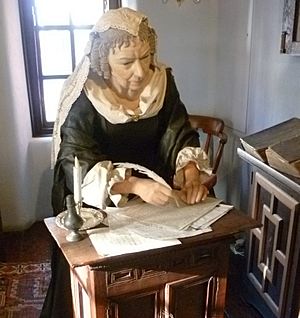Anne Halkett facts for kids
Quick facts for kids
Anne Halkett
|
|
|---|---|

A figure of Lady Anne Halkett figure at the Abbot House, Dunfermline
|
|
| Born | c. 1623 |
| Died | c. 1699 (aged 75-78) |
| Occupation | Writer and autobiographer |
| Years active | 1644–1699 |
| Spouse(s) |
Sir James Halkett
(m. 1656) |
| Parents |
|
Anne Halkett (born Murray) lived from about 1623 to 1699. She was an English writer. She is famous for her religious writings and her autobiography. People also knew her as Lady Halkett.
Contents
Anne Halkett's Early Life
Anne Halkett's father was Thomas Murray. He taught the children of King James I. Later, he became the head of Eton College, known as a Provost. Her mother, Jane Drummond Murray, was a governess. This meant she also looked after the king's children.
After her father died, Anne's mother taught her at home. Anne learned many things. These included French, dancing, and music. She also studied medicine, needlework, and surgery. Her religious education was very important. She read the Bible every day. She also said daily prayers and went to church often. In 1639, a family friend gave her a diamond ring.
Anne Halkett's Personal Life
Anne Halkett had a first relationship with Thomas Howard. His family was important but not rich. This meant they could not easily marry. Anne's mother did not approve. She wanted to stop Anne from making a bad choice. So, she had someone sleep in Anne's room. She also told Anne not to see Thomas again. Anne said goodbye to him while wearing a blindfold. This showed her loyalty to her mother. This disagreement with her mother lasted for over a year. Thomas Howard later broke his promise not to marry anyone else. Anne wrote that his marriage was not a happy one.
Helping the Royalists
Anne then had a relationship with Colonel Joseph Bampfield. He was a Royalist soldier. During the English Civil War, Anne helped him. She took part in brave plans for the Royalist side. They helped James, Duke of York escape. He later became King James II. He was being held by Parliament. Anne disguised him as a woman to help him get away. She wrote that he "was very pretty in it." She gave him food and a special cake he liked. Then she sent him safely to Europe.
Anne seemed to live with Bampfield because he promised to marry her. But she later found out he was already married.
Life in Scotland
Anne Halkett later moved to Scotland. She met King Charles at Dunfermline Palace. She worked as a doctor in Scotland. She helped people in Kinross and at Fyvie Castle. She stayed there with the Countess of Dunfermline. Bampfield came to visit her at Fyvie.
In 1652, she stayed at Floors Castle for a few days. She was with the Countess of Roxburghe. When she returned to Edinburgh, she stayed with Sophia Lindsay. Sophia was the wife of Sir Robert Moray. She lived in Lord Tweeddale's house. Sophia died a few days after Christmas. In February, Anne moved to a new place in Blackfriar's Wynd.
Marriage and Later Life
Anne later became a governess for Sir James Halkett's daughters. He was a widower. They married in 1656 at Charlton House. Their wedding was a small ceremony.
Anne was happily married to Sir James for 20 years. She wrote a book called The Mother's Will to her Unborn Child when she was pregnant. After Sir James died, she did not have much money. She earned a living by teaching children from noble families at her home. Her money problems got better later. King James II gave her a pension. This was for her help during the English Civil War.
When Anne Halkett died, she left behind many writings. These included 21 large books of manuscripts. She wrote them between 1644 and the late 1690s. These important papers are now kept at the National Library of Scotland.
Anne Halkett's Written Work
Anne Halkett's writings include a long autobiography. She also wrote religious thoughts and Instructions for Youth. For Anne, writing was part of her daily life. She wrote about what she read. She also wrote about her dreams and hopes for her children. It was for her religious practice and for fun. Her religious writings were created over 55 years.
Her Autobiography
Anne Halkett's autobiography is a very open record. It tells about her personal life and political events. These events happened during the English Civil War. She wrote it between 1677 and 1678. In this book, Anne shares many details. She writes about her courtships and her marriage. The book is exciting to read. It uses conversations to show Anne's feelings. It also shows the feelings of the people she met.

